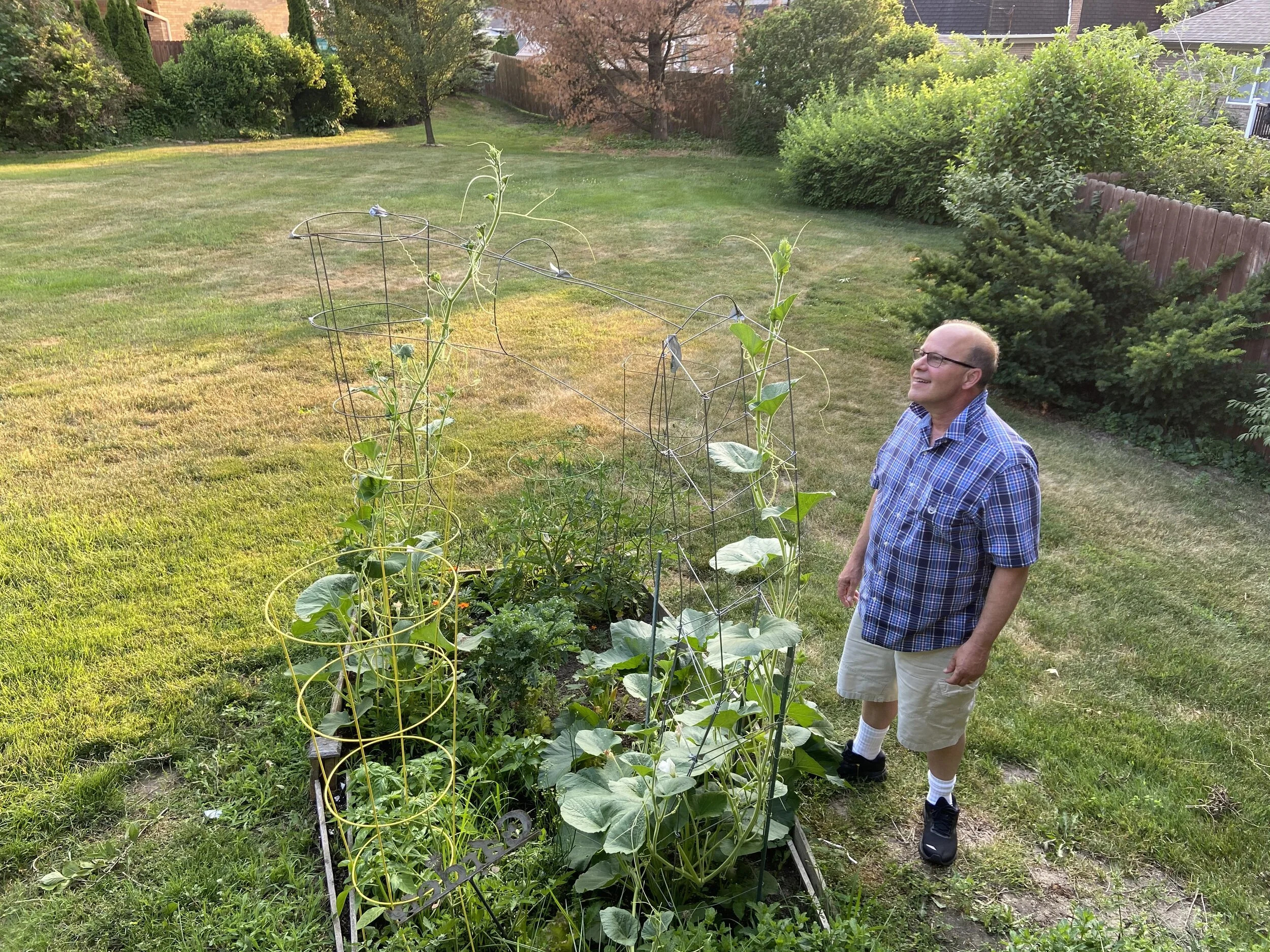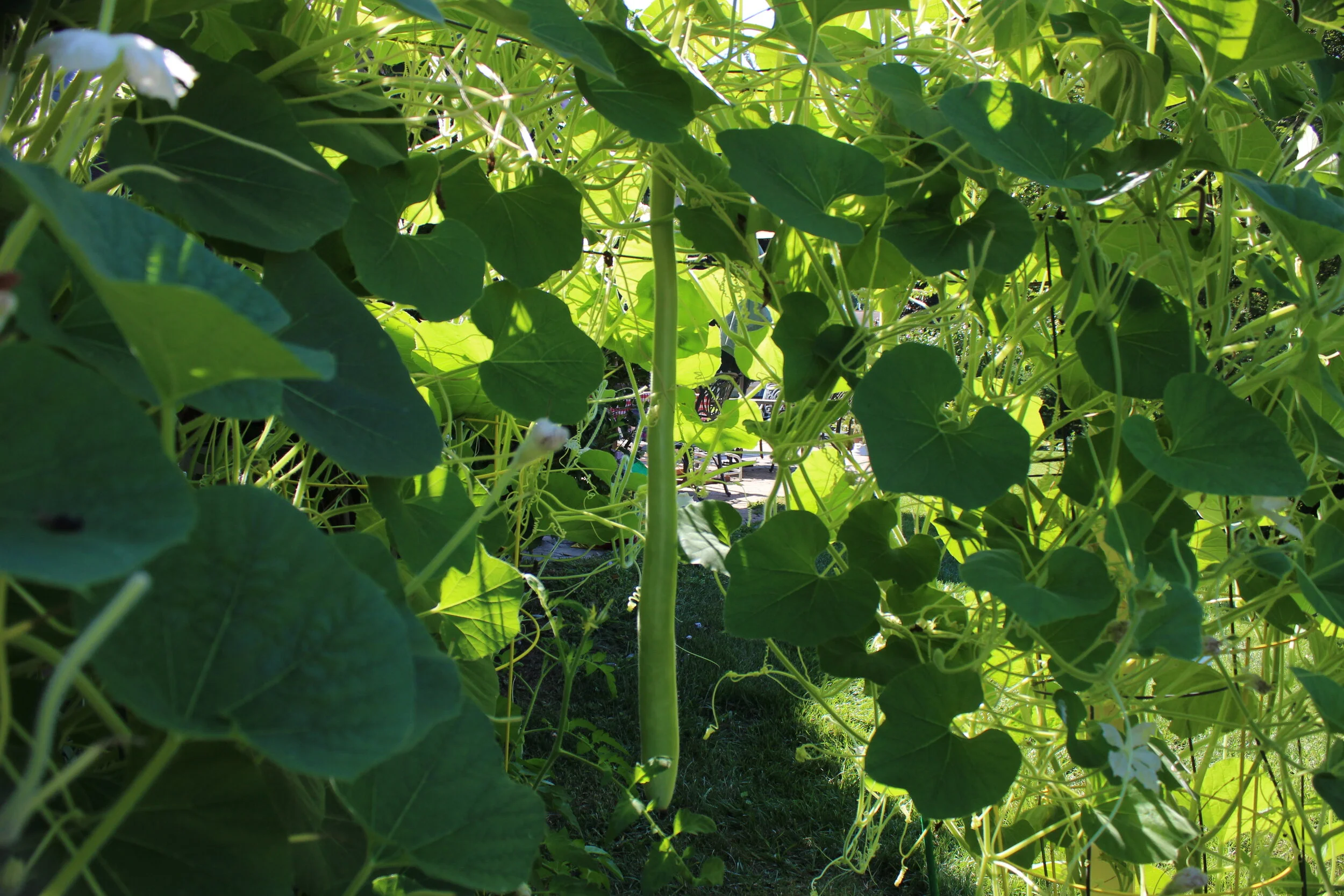My bella Cucuzza! There is so much joy, excitement, and profound amazement that comes from growing Cucuzza squash. Being a careful tender to this traditional Sicilian-grown fruit plant has given me quite a hobby over the past couple of months. To me, growing Cucuzza is all the thrills of fishing right in the backyard garden. After hand-pollinating and casting pollen into the female flowers, you go out a few days later to see if you’re growing a big one. And if one’s ready for harvest, you snip it down and hoist it up for a prideful photo. Measure it up on the table and send it to the kitchen to cook it up. Any way you look at it, it’s good fun and makes for a great healthy meal.
The key to Cucuzza growing success is hand pollination. Of course, you could rely on the labor of ants or bees to pollinate but nothing is as good as the hands of a Sicilian-American boy eager to spring glorious Cucuzza into being. (Your hands will do great too, I promise!) The Cucuzza is indeed a prolific plant, with just two vines we’ve harvested 23 (and counting!)* and each has grown to be just about three feet long. We’ve had so many, we’ve been delivering them to relatives and I even wrapped one up for my niece to open up on her 13th birthday. She won’t forget that one.
*the current season harvest total ended up well over 30, a high bar for next season!
The cucuzza. As big as a nephew.
With cucuzza, there are so many beautiful meals you can make. Pasta with Tenerumi is the classic Sicilian dish. It’s a tasty soup, using the small, tender leaves. (You can feast your eyes on the photo shoot I had below for how that looks.) Cucuzza can also be cooked in any way you would eat your regular zucchini: served with pasta and tomatoes, roasted with veggies in olive oil or sautéed to your liking — you really can’t go wrong and there’s lots of tasty recipes around the internet to guide you.
Next year we’re upgrading to some form of a trellis, but this year being our first we had no idea what to expect. What happened was that the plant quite literally bursted out of the ground and reached for the sky. Our method of supporting it was to construct a kluge out of tomato cages, wood stakes, duct tape and various things we could find in the garage. It grows wild. While supporting it is essential, the other must-do is to hand pollinate every couple days. First, you need to learn how to spot the male and female flowers.
Cucuzza, taller than Dad.
Spotting the male and females is an important skill and an easy one to learn. Below is a male flower. Notice how the stem goes straight into the flower. In the early stages of the plant, the male flowers seem to be a bit more common, so stay calm if your plant is young and you’re only seeing males.
Male Cucuzza flower. Notice the flower goes directly into the stem. (No sight of budding fruit.)
On the inside of the male flower, take note and notice the little pollen peg, the stamen.
Male Cucuzza flower open. Notice pollinator peg or stamen on the inside.
The females have a distinct bright green shaft, that is noticeably thicker than the stem. It’s the start of the cucuzza squash, sometimes they have a bit of a curve or twist to them as well. This is an early spotted female flower, just before it’s opening.
Female Cucuzza flower. Notice the bright green shaft. It’s the budding fruit!
Female Cucuzza flower open. Notice the bright green pollinator receptor grips (called pistils)
When open or when the flower pedals become flexible enough to open with your fingers, the female flower is ready to pollinate. Take a male flower head, pick off the pedals and gently touch the pollen stem into the rubbery looking female pistil receptors. I like to even peel back the stem skin around the male pollen stamen and brush all that pollen dust into the female. You can also use a Q-tip to swab the insides and exchange the pollen of the flowers, but there’s plenty of male heads to pluck and use and I find that easier to do. In just a couple of days, you’ll notice the cucuzza start to grow several inches and eventually develop into its magnificent shape. As another note, I’ve read it’s better to crossbreed from a different cucuzza plant. So if you have more than one, try grabbing your male heads or swabbing from one to another.
Cucuzza growing in vines, ready to harvest.
Right when they’re about 3’ long they’re ripe and ready to harvest. I (and my mom who cooks them) prefer to harvest them when they’re still slightly thin. They seem to have less seeds and just the right amount of tender texture.
Forza Cucuzza!
Lastly, posing with your gigantic and absurdly long fruit is an absolute must. Hoist it up with honor and enjoy your bella cucuzza.
Cucuzzas and me.
Cucuzza vs. Sicilia
3’ 1” — A nice Cucuzzi catch!
Cucuzza + Tenerumi = Happy Roz
Meeee! So many cucuzza.














